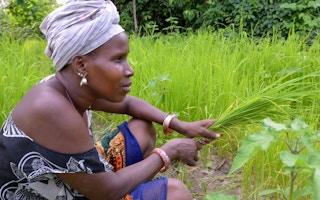Science and technology offer exciting pathways for rural women to tackle the challenges they face daily. Innovative solutions for rural women can, for example, reduce their workload, raise food production and increase their participation in the paid labour market. But even the very best innovative, gender-appropriate technology makes no sense without access to other critical resources, especially secure land rights, which women in rural areas need to flourish.
Land degradation and drought affect, at least, 169 countries. The poorest rural communities experience the severest impacts. For instance, women in areas affected by desertification, easily spend four times longer each day collecting water, fuelwood and fodder.
Moreover, these impacts have very different effects on men and women. In the parts of Eritrea impacted most by desertification, for example, the working hours for women exceed those of men by up to 30 hours per week.
Clearly, poor rural women would benefit the most from new ways of working on the land. Therefore, technology and innovation must benefit women and men equally for it to work well for society. Even more so at a time when technology is becoming critical to manage the growing threats of desertification, land degradation and drought.
In Turkey, for instance, farmers can get information on when to plant in real time, using an application installed on a mobile phone.
“
Women in areas affected by desertification, easily spend four times longer each day collecting water, fuelwood and fodder.
However, in most part of the world, the adoption rates of technology are especially low among rural women, possibly because very often technologies are not developed with rural women land users in mind. For example, a wheelbarrow can reduce the time spent on water transport by 60 per cent. But its weight and bulk makes it physically difficult for most African women to use.
The demand for technology design that meets rural women’s specific needs is great. But developing appropriate technology is not enough, if the pre-requisites for technology uptake, in particular access to land, credit and education, are not in place. Today, a web of laws and customs in half the countries on the planet undermine women’s ability to own, manage, and inherit the land they farm.
In nearly many developing countries, laws do not guarantee the same inheritance rights for women and men. In many more countries, with gender equitable laws, local customs and practices that leave widows landless are tolerated.
For instance, a 2011 study carried out in Zambia shows that when a male head of household dies, the widow only gets, on average, one-third of the area she farmed before. The impact of such changes on the world’s roughly 258 million widows and the 584 million children who depend on them is significant. It leaves us all worse off.
Globally, women own less land and have less secure rights over land than men. Secure access to land increases women’s economic security, but it has far greater benefits for society more generally. Women who own or inherit land also control the decisions that impact their land, such as the uptake of new technology.
A study in Rwanda shows that recipients of land certificates are twice as likely to increase their investment in soil conservation relative to others. And, if women got formal land rights, they were more likely to engage in soil conservation. Initiatives that benefit rural women do not stop at the household or local levels. At scale, such investments have a huge global impact.
If women all over the world had the same access as men to resources for agricultural production, they could increase yields on their farms by 20 to 30 per cent. This could raise the total agricultural output in developing countries substantially at national scales, and reduce the number of undernourished people in the world by 12 to 17 per cent.
If we want to tackle the underlying causes of gender inequality, to build smart and innovate for change, then technology is good. Innovative, gender appropriate technology is better. But these will have little impact if the pre-requisites for its uptake by women, in particular access to land, credit and education, are non-existent.
Ibrahim Thiaw is Under-Secretary General of the United Nations and Executive Secretary of the United Nations Convention to Combat Desertification. This article was originally published on Inter Press Service.


















